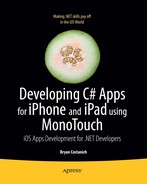Book Description
Developing C# Applications for iPhone and iPad using MonoTouch shows you how to use your existing C# skills to write apps for the iPhone and iPad. Fortunately, there's MonoTouch, Novell's .NET library that allows C# developers to write C# code that executes in iOS. Furthermore, MonoTouch allows you to address all the unique functions of the iPhone, iPod Touch, and iPad. And the big plus: You needn't learn any Objective-C to master MonoTouch!
Former Microsoft engineer and published app-store developer Bryan Costanich shows you how to use the tools you already know to create native apps in iOS using C# and the .NET Base Class Libraries. The magic is in Novell's implementation of Apple's Cocoa libraries in MonoTouch. You'll master the same elegant and rich Cocoa environment, but without the need to learn a new programming language.
Developing C# Applications for iPhone and iPad using MonoTouch takes you from your first "Hello, World" example through the major APIs and features of iOS. The coverage is comprehensive and makes use of frequent examples, complete with sample code you can download and reuse to create your own powerful and playful apps.
What you'll learn
How to use your existing C# skills to develop applications on the iPhone and iPad
Apple's Model View Controller (MVC) methodology
Working with CocoaTouch's UIKit to create iOS applications using native controls
Device-specific features, like the camera, GPS, and Compass using CoreLocation, the accelerometer, and others
Accessing shared resources such as the photos, contacts, and more
How to persist and retrieve data using SQLite and .NET libraries
Complex drawing and animation using CoreGraphics and CoreAnimation
The use of Apple's Push Notification Service
The latest game porting techniques using XNA Touch
How to integrate off-the-shelf Objective-C libraries
Who this book is for
Every .NET and C# developer who has have ever wanted to create an application or game for Apple's App Store.
Table of Contents
- Copyright
- About the Author
- About the Technical Reviewer
- Acknowledgments
- Preface
- 1. Getting Started with MonoTouch
- 1.1. Developing for the iPhone and iPad
- 1.2. MonoTouch Background
- 1.3. Getting Started
- 1.4. Summary
- 2. Our First Application
- 3. Creating Multi-Screen Applications Using the MVC Pattern
- 4. iPad and Universal (iPhone/iPad) Applications
- 5. More on Views and Controllers
- 5.1. Custom UIViewController and UIView Implementations
- 5.2. Managing More than One View in a Controller
- 5.3. Handling Rotation
- 5.4. Summary
- 6. Introduction to Controls
- 7. Standard Controls
- 8. Content Controls
- 8.1. Navigation Controller
- 8.2. Tab Bar Controller
- 8.3. Split View Controller
- 8.4. Web View
- 8.5. Map View
- 8.6. Search Bar
- 8.7. Summary
- 9. Working with Tables
- 10. Working with Keyboards
- 11. Multitasking
- 12. Working with Touch
- 12.1. When to Use Which?
- 12.2. Enabling Touch
- 12.3. Touch Events
- 12.4. Gesture Recognizers
- 12.5. Summary
- 13. Working with Shared Resources
- 13.1. File System
- 13.2. Device Battery
- 13.3. Address Book/Contacts
- 13.4. Photos and Camera
- 13.4.1. UIImagePickerController
- 13.4.1.1. Determining Support
- 13.4.1.2. Creating the Image Picker
- 13.4.1.3. Configuring the Image Picker
- 13.4.1.4. Providing a Custom Camera Overlay
- 13.4.1.5. Displaying the Image Picker
- 13.4.1.6. Handling Image Picker Events
- 13.4.1.7. Implementing a UIImagePickerControllerDelegate
- 13.4.1.8. Canceled Event/Method
- 13.4.1.9. FinishedPickingMedia Event/Method
- 13.4.2. AV Foundation Framework
- 13.4.1. UIImagePickerController
- 13.5. Network Activity Indicator
- 13.6. Accelerometer
- 13.7. Summary
- 14. User and Application Settings
- 15. Working with CoreLocation
- 16. Drawing with CoreGraphics
- 17. Core Animation
- 17.1. View-Based Animation Framework
- 17.2. Advanced Core Animation with Layers
- 17.3. Summary
- 18. Notifications
- 18.1. How Notifications Work
- 18.2. Scheduling Local Notifications
- 18.3. Handling Notifications
- 18.4. Push Notifications
- 18.5. Summary
- 19. Working with Data
- 20. Publishing to the App Store
- 21. Third-Party Libraries
- 22. Using Objective-C Libraries and Code
- 22.1. btouch
- 22.2. A Quick Objective-C Primer
- 22.3. Compiling the Objective-C Library
- 22.3.1. Building the Tapku Library
- 22.3.2. Creating API Definition File and Helper Code
- 22.3.3. Running btouch
- 22.3.4. Adding the Compiled Objective-C Library
- 22.3.5. Referencing the Wrapper DLL
- 22.3.6. Configuring the Build
- 22.3.7. Using the Library
- 22.4. Summary
